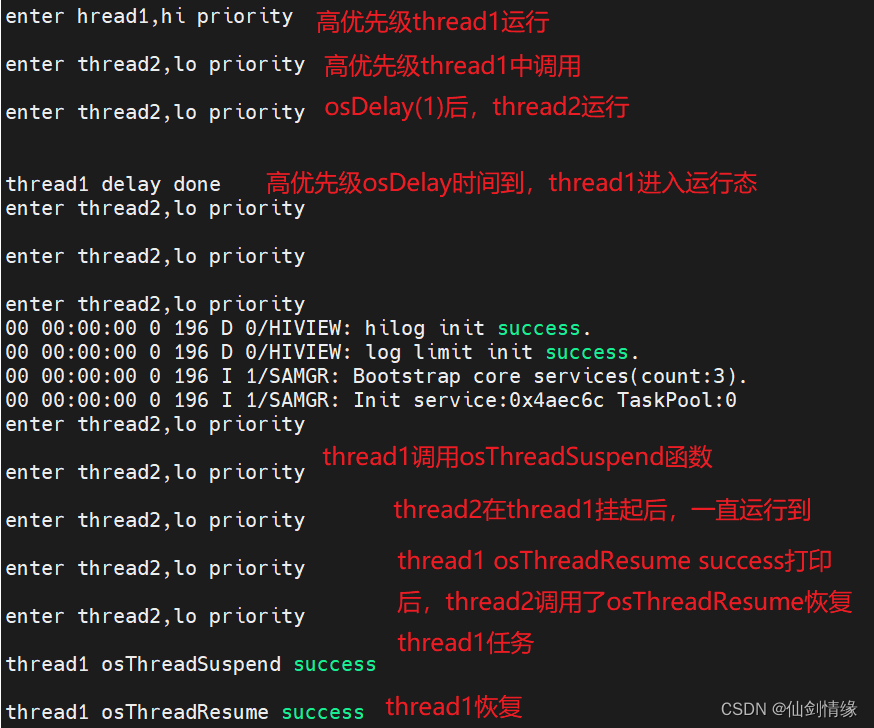Bearpi开发板之HarmonyOS任务管理
管理 任务 开发板 HarmonyOS
2023-09-14 09:06:41 时间
任务管理简介
- 基本概念
1、从系统的角度看,任务是竞争系统资源的最小运行单元。任务可以使用或等待CPU、使用内存空间等系统资源,并独
立于其它任务运行。
2、LiteOS的任务模块可以给用户提供多个任务,实现了任务之间的切换和通信,帮助用户管理业务程序流程。这样用户
可以将更多的精力投入到业务功能的实现中。
3、LiteOS中的任务是抢占式调度机制,高优先级的任务可打断低优先级任务,低优先级任务必须在高优先级任务阻塞或
结束后才能得到调度,同时支持时间片轮转调度方式。
4、LiteOS的任务默认有32个优先级(0-31),最高优先级为0,最低优先级为31。
5.但cmsis_os2的优先级刚好相反,0为最低优先级
任务状态
- 任务状态通常分为以下四种:
就绪(Ready):该任务在就绪列表中,只等待CPU。
运行(Running):该任务正在执行。
阻塞(Blocked):该任务不在就绪列表中。包含任务被挂起、任务被延时、任务正在等待信号量、读写队列或者等待读
写事件等。
退出态(Dead):该任务运行结束,等待系统回收资源。
任务相关概念
- 任务ID:在任务创建时通过参数返回给用户,作为任务的一个非常重要的标识。
任务优先级:优先级表示任务执行的优先顺序。 - 任务入口函数:每个新任务得到调度后将执行的函数。
- 任务控制块TCB:每一个任务都含有一个任务控制块(TCB)。TCB包含了任务上下文栈指针(stack pointer)、任务状态、
任务优先级、任务ID、任务名、任务栈大小等信息。TCB可以反映出每个任务运行情况。 - 任务栈:每一个任务都拥有一个独立的栈空间,我们称为任务栈。
- 任务上下文:任务在运行过程中使用到的一些资源,如寄存器等,我们称为任务上下文。LiteOS在任务挂起的时候会将本
任务的任务上下文信息,保存在自己的任务栈里面,以便任务恢复后,从栈空间中恢复挂起时的上下文信息,从而继续执
行被挂起时被打断的代码。 - 任务切换:任务切换包含获取就绪列表中最高优先级任务、切出任务上下文保存、切入任务上下文恢复等动作。
任务状态迁移说明
- 就绪态→运行态:任务创建后进入就绪态,发生任务切换时,就绪列表中最高优先级的任务被执行,从而进入运行态,但此刻该任务依旧在就绪列表中。
- 运行态→阻塞态:任务运行因挂起、读信号量等待等,在就绪列表中被删除进入阻塞。
阻塞态→就绪态(阻塞态→运行态):阻塞的任务被恢复后(任务恢复、延时时间超时、读信号量超时或读到信号量等),此时被恢复的任务会被加入就绪列表,从而由阻塞态变成就绪态;此时如果被恢复任务的优先级高于正在运行任务的优先级,则会发生任务切换,将该任务由就绪态变成运行态。 - 就绪态→阻塞态:任务也有可能在就绪态时被阻塞(挂起)。
- 运行态→就绪态:有更高优先级任务创建或者恢复后,发生任务切换而进入就绪列表。
- 运行态→退出态:任务运行结束,内核自动将此任务删除,此时由运行态变为退出态。
- 阻塞态→退出态:阻塞的任务调用删除接口,任务状态由阻塞态变为退出态。
实现任务管理
- cmsis_os2的API任务接口简介
- 创建任务:osThreadId_t osThreadNew(osThreadFunc_t func,void * argument,const osThreadAttr_t * attr)
- 删除某个任务:osStatus_t osThreadTerminate(osThreadId_t thread_id);
- 任务挂起:osStatus_t osThreadSuspend(osThreadId_t thread_id)
- 任务恢复:osStatus_t osThreadResume (osThreadId_t thread_id)
创建2个任务
#include <stdio.h>
#include <unistd.h>
#include "ohos_init.h"
#include "cmsis_os2.h"
#include "wifiiot_gpio.h"
#include "wifiiot_gpio_ex.h"
osThreadId_t thread1_id;
osThreadId_t thread2_id;
void thread1(void)
{
int sum = 0;
while(1)
{
printf("This is BearPi Harmony Thread1----%d\r\n", sum++);
usleep(1000000);
}
}
void thread2(void)
{
int sum = 0;
while(1)
{
printf("This is BearPi Harmony Thread2----%d\r\n", sum++);
usleep(500000);
}
}
void my_led_example(void)
{
GpioInit();
IoSetFunc(WIFI_IOT_IO_NAME_GPIO_2,WIFI_IOT_IO_FUNC_GPIO_2_GPIO);
GpioSetDir(WIFI_IOT_IO_NAME_GPIO_2,WIFI_IOT_GPIO_DIR_OUT);
osThreadAttr_t attr;
attr.name = "thread1";
attr.attr_bits = 0U;
attr.cb_mem = NULL;
attr.cb_size = 0U;
attr.stack_mem = NULL;
attr.stack_size = 1024 * 4;
attr.priority = 25;
if (osThreadNew((osThreadFunc_t)thread1, NULL, &attr) == NULL)
{
printf("Falied to create thread1!\n");
}
attr.name = "thread2";
if (osThreadNew((osThreadFunc_t)thread2, NULL, &attr) == NULL)
{
printf("Falied to create thread2!\n");
}
}
APP_FEATURE_INIT(my_led_example);
BUILD.gn中加入以下内容
static_library("myled") {
sources = [
"myled.c"
]
include_dirs = [
"//utils/native/lite/include",
"//kernel/liteos_m/components/cmsis/2.0",
"//base/iot_hardware/interfaces/kits/wifiiot_lite",
"//kernel/liteos_m/components/cmsis/2.0",
]
}
编译烧录运行

扩展实验代码
#include <stdio.h>
#include <unistd.h>
#include "ohos_init.h"
#include "cmsis_os2.h"
#include "wifiiot_gpio.h"
#include "wifiiot_gpio_ex.h"
osThreadId_t thread1_id;
osThreadId_t thread2_id;
void thread1(void)
{
printf("enter hread1,hi priority\r\n");
osDelay(1);
printf("\r\nthread1 delay done\r\n");
osThreadSuspend(thread1_id);
printf("\r\nthread1 osThreadResume success\r\n");
osThreadTerminate(thread1_id);
}
void thread2(void)
{
for(int i=0; i<10; i++)
{
printf("\r\nenter thread2,lo priority\r\n");
}
printf("\r\nthread1 osThreadSuspend success\r\n");
osThreadResume(thread1_id);
osThreadTerminate(thread2_id);
}
void my_led_example(void)
{
GpioInit();
IoSetFunc(WIFI_IOT_IO_NAME_GPIO_2,WIFI_IOT_IO_FUNC_GPIO_2_GPIO);
GpioSetDir(WIFI_IOT_IO_NAME_GPIO_2,WIFI_IOT_GPIO_DIR_OUT);
osThreadAttr_t attr;
attr.name = "thread1";
attr.attr_bits = 0U;
attr.cb_mem = NULL;
attr.cb_size = 0U;
attr.stack_mem = NULL;
attr.stack_size = 1024 * 4;
attr.priority = 25;
thread1_id = osThreadNew((osThreadFunc_t)thread1, NULL, &attr);
if (thread1_id == NULL)
{
printf("Falied to create thread1!\n");
}
attr.name = "thread2";
attr.priority = 24;
thread2_id = osThreadNew((osThreadFunc_t)thread2, NULL, &attr) ;
if (thread2_id == NULL)
{
printf("Falied to create thread2!\n");
}
}
SYS_RUN(my_led_example);
- 编译烧录运行

相关文章
- 从零开始学习UCOSII操作系统4–任务管理
- appscan激活成功教程版安装_appscan许可证管理在哪
- 软件持续交付速度提升 40%!DevOps 制品管理有何魔力?
- Linux线程栈:管理复杂任务的最佳方式(linux线程栈)
- 任务MySQL事件和计划任务管理(mysql事件与计划)
- 定时任务Linux下定时任务管理实战(linux如何执行)
- Linux 文件权限管理:添强安全性(linux文件添加权限)
- Linux禁止远程登录:管理安全性(linux拒绝远程登录)
- Linux日志管理:轻松记录系统信息(linux日志输出)
- 软件Linux下的CRM软件:实现客户关系管理的利器(linuxcrm)
- Linux下的任务管理:一种新的体验(linux的任务管理器)
- 使用EVMS实现Linux磁盘管理(linuxevms)
- 管理Linux定时任务管理:提升工作效率的有效方法(linux的定时任务)
- Linux下定时任务的自动化管理(linux定时任务命令)
- Linux运维管理:每日实践任务(linux运维日常工作)
- 利用 Oracle 触发器实现自动化任务管理(oracle触发器类型)
- Linux进度条:让操作更直观,任务易管理(linux进度条)
- 探究Oracle的Jobs:任务管理与自动化流程(oracle的jobs)
- 简单实用的Linux文件提取方法,让你高效解压和管理各种文件(linux提取文件)
- 更SQL Server复制方式下的变更管理(sqlserver复制变)
- SQL Server 127下的数据库管理(sqlserver127)
- MySQL 二进制存储解决方案:高效实现储存以及管理的必要(mysql二进制存储)
- MySQL中的人数管理技巧(mysql中人数)
- 中利用Redis管理统计信息的方法研究(统计信息放在redis)
- Oracle系统触发器自动实现任务管理(oracle中系统触发器)
- aion层基于Oracle的Foundation层实现的数据库管理(oracle中found)
- Oracle三大服务安全可靠性与管理(oracle三大服务)
- SQLServer数据库自动执行管理任务
- js文件缓存之版本管理详解

